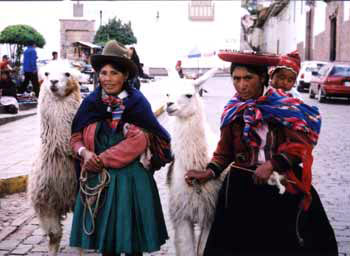“What is your first thought when you hear the
word “empire?” The Roman Empire? The British Empire, on which
the sun never sets? “Star Wars?”
At the time Europeans arrived in South America the Incas had the largest
empire in the world, covering as much territory as had the Romans, five
centuries earlier. From Ecuador to the center of Chile, the dominion
of the Incas stretched almost 3,400 miles.
Like the Romans, the Incas had an extensive network of highways. Although
they never developed the wheel, the Incas built 25,000 miles of roads.
These highways, many of which were stone-paved and up to 24 feet wide,
carried couriers, armies and cargo-laden llamas throughout the sprawling
territories. Their use was restricted to those on official government
business.
At the peak of the empire, the Incas ruled almost 12 million people who
belonged to a hundred different ethnic groups.
Just as the Romans introduced Latin as the common language of their empire,
so the Incas made Quechua their official language. Quechua is still spoken
throughout the Andes today.
Besides their skills at building, the Incas were masters of agriculture,
terracing their rugged mountains and breeding wild plants into strains
which would grow in the dry, high altitudes. One of the results of this
was the potato. Just think, without the Incas we would have no French-fries,
baked potatoes, potato salad, potato chips, and probably much less cholesterol.
To insure a constant supply of food to all of their subjects, the Incas
built thousands of storage sites and developed methods to preserve food.
Freeze-drying today is accomplished with equipment developed for the
space program, but the Incas achieved the same result by utilizing the
harsh weather of the Andes. Potatoes were left outside at night to freeze.
In the daytime, the hot sun evaporated the moisture, resulting in a freeze-dried
potato pulp called chuño. The same process was used to preserve
beef. They called the dried beef charqui, a Quechua word we still use
today, only we spell it “jerky.”
For those who like Ceviche, seafood “cooked” by citric acid,
they can also thank the Incas for this culinary invention.
To preserve corn, Inca farmers dried it for storage. When heat was applied
to the dried corn the result was—you guessed it, popcorn! Five
hundred years before the invention of the movie theater, the Incas were
munching on crispy popcorn and getting the kernels caught in their teeth.
Click Here for information on our Peru Tours.



